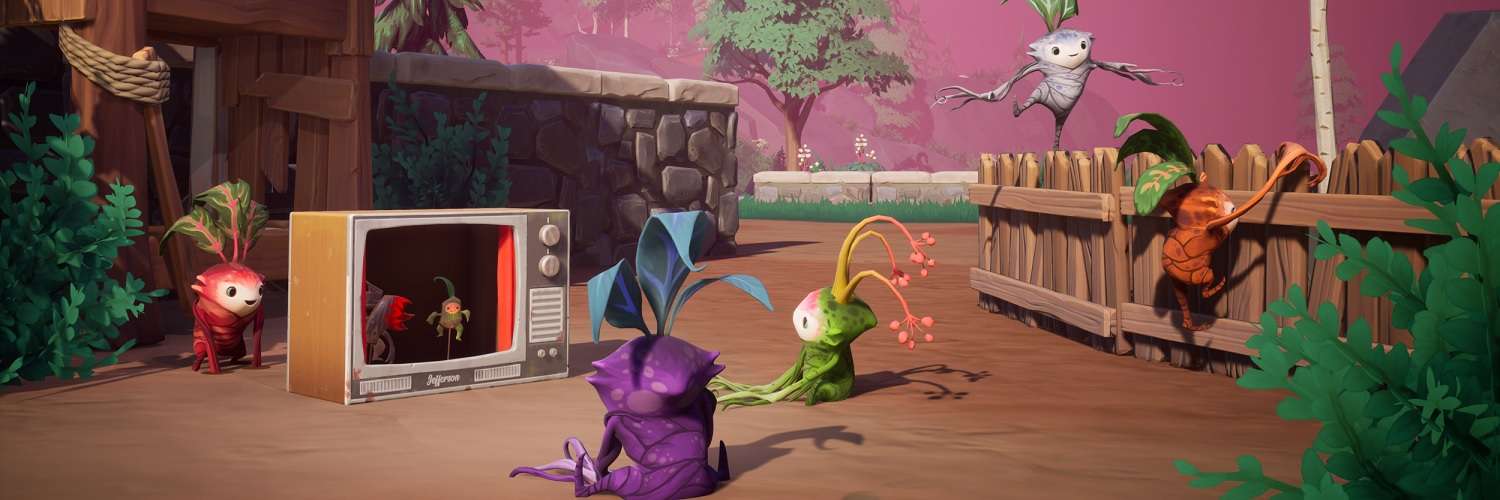
Drake Hollow PC Review
I rather enjoyed The Molasses Flood’s first game, The Flame in the Flood, a beautiful, roguelike survival title about trying to get as far down the river using anything found in the environment to survive. Due to this, I was excited to see what the independent studio’s next game would be. A couple of trailers appeared during Microsoft events over the past year for their new game, called Drake Hollow, which turns out to be another take on the survival genre. This time, the developers have put more focus on scavenging for materials to support its new base building and growth mechanics that give Drake Hollow added depth over the developer’s previous title.
After going through a basic character creator that allows to either pick a male or female avatar, a few face designs, then onto styling the avatar with hats, shirts, pants, shoes and backpacks, the adventure then begins into the world of Drake Hollow. An introduction shows the avatar seemingly bored out of their brains as they check their phone and toss a few stones into the river before a crow with rather strange glowing green eyes and a large golden compass around its neck stares directly at the avatar before flying off. As any bored person would do, the player follows the crow into a strange door portal that teleports the character into The Hollow, a world of drakes and feral, where your task is to protect these little vegetable drakes, who are native to The Hollow, from the invading feral.
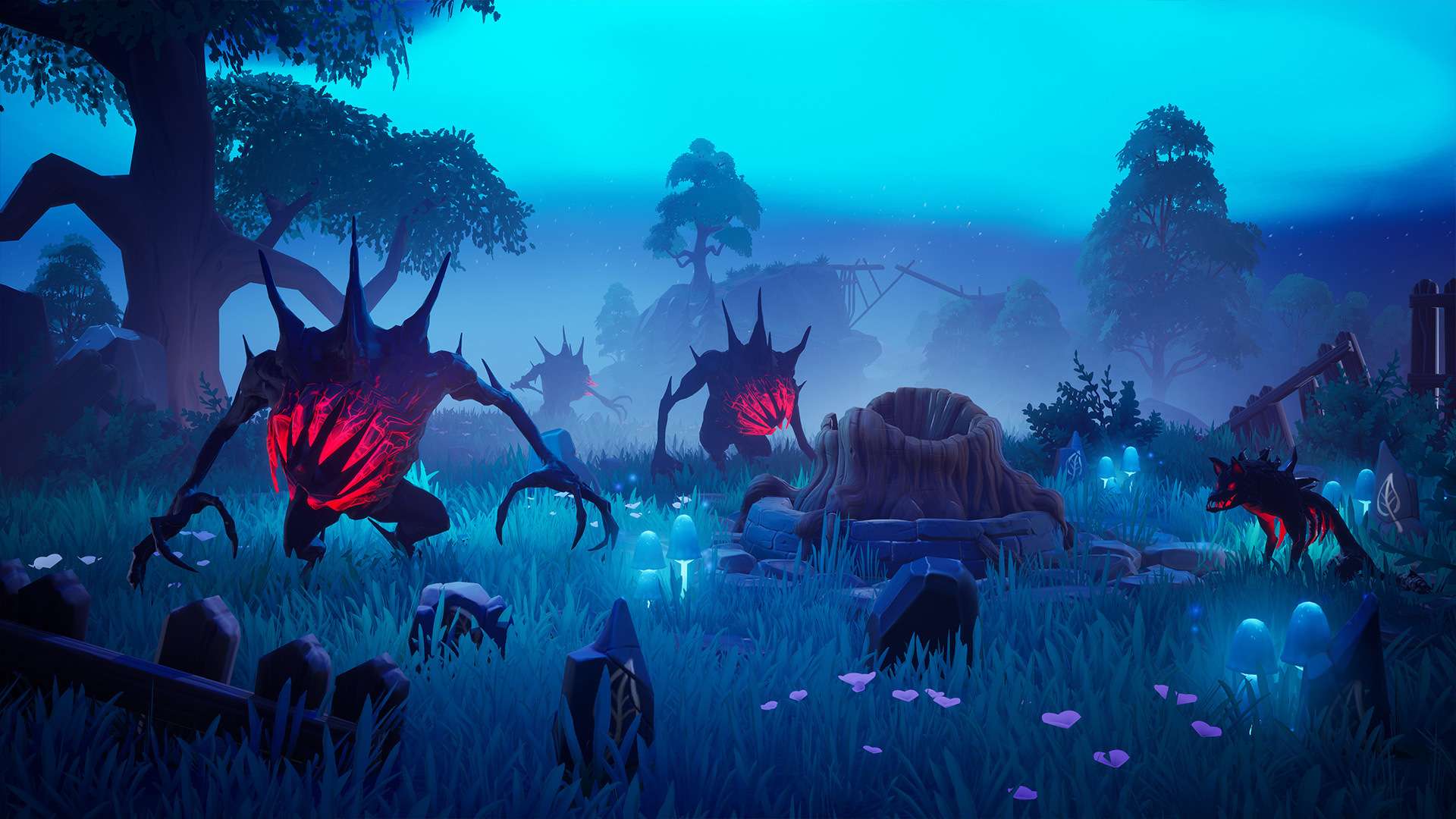
Story is set within the campaign, but it is only small element of Drake Hollow. It is delivered in a simple manner through short dialogue with the limited characters in the game. There are the occasional drawn art for cutscenes with a little action to go with it, but a lot of the story is built around finding notes left by characters in the world who were here before you. These can hold some compelling information that drip feeds little hints to developer your idea of what has gone on before you arrived at The Hollow, but do not go into the game expecting to have big story beats or be wooed by some refreshing tale. The story is used to build a world and setting, and then leave it to the player to go off and explore the islands around their base.
Exploring is a part of any survival game, but unlike some titles, the survival element in Drake Hollow is not about keeping your avatar alive. Death means returning back to base or respawning as a ghost at base and forced to travel to the body to resurrect it without suffering the weapon durability handicap. The game’s goal is to protect the mythical creatures, called drakes, from the dangers of ferals, while also looking after them, being a sort of babysitter for plants to keep them from dying. These tiny plant people come in a multitude of colours and are some of the cutest critters pumped with adorable personality that comes through their animations. I don’t think anything else will come close to beating their cuteness in a video game in 2020.
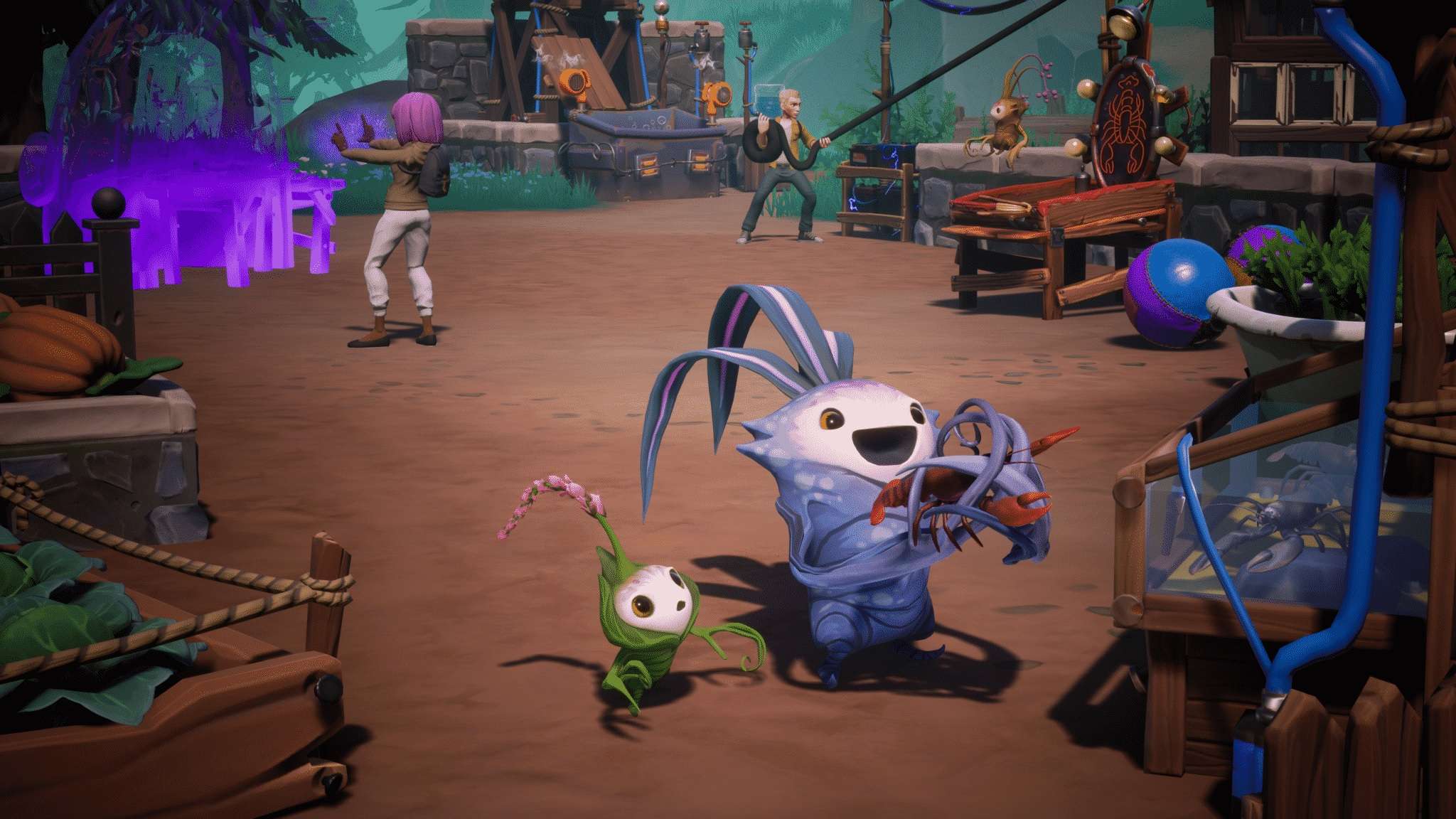
Drakes are randomly hidden around the scattered islands on the map, so as the player begins to explore further away from base these little drakes are discovered and sent back to base to live their life in a new home. The base mechanics are tied to the drakes, so the more found, the more the base will level up. Drakes can also age when given their specific crystal type – again, these are items found from killing enemies on the map – and will also continue to add to the base experience to level it up. As the base level increases more items become unlocked. One other thing to mention with drakes is that each one comes with a buff that can be equipped to the player, initially one can be equipped, but up to four as the base levels up. These mods can help in many areas of the game – health regeneration on hit, extra defence, cheap prices in the magpie shop, more chance of rare items, and many others – and what is even better is as the drakes age up from the crystals the buffs become stronger.
Building is key to keeping the drakes alive and so the player must keep the demand for food and water above the requirement to keep them healthy. There is also a third statistic, entertainment, which if left unchecked means the drakes will simply die of boredom. Early game offers basic home furniture, such as disposable beds that vanish after one night, dolls for entertainment and water wells. As the base grows, bigger and more efficient tools become available, such as triple bunk beds, water pumps, greenhouses, and other means to make the base more self efficient and less depending on the player. When a base is fully functionally the drakes will look after themselves when it comes to the food and water. Also, seeing the drakes use the entertainment objects is such a gleeful experience. Where else will you see cute little plant people break the dance floor with a 70s disco mat or watch some plant TV? Getting to this point with the base allows the player more free time to go off and explore the islands without wondering if the drakes have died from the lack of entertainment.
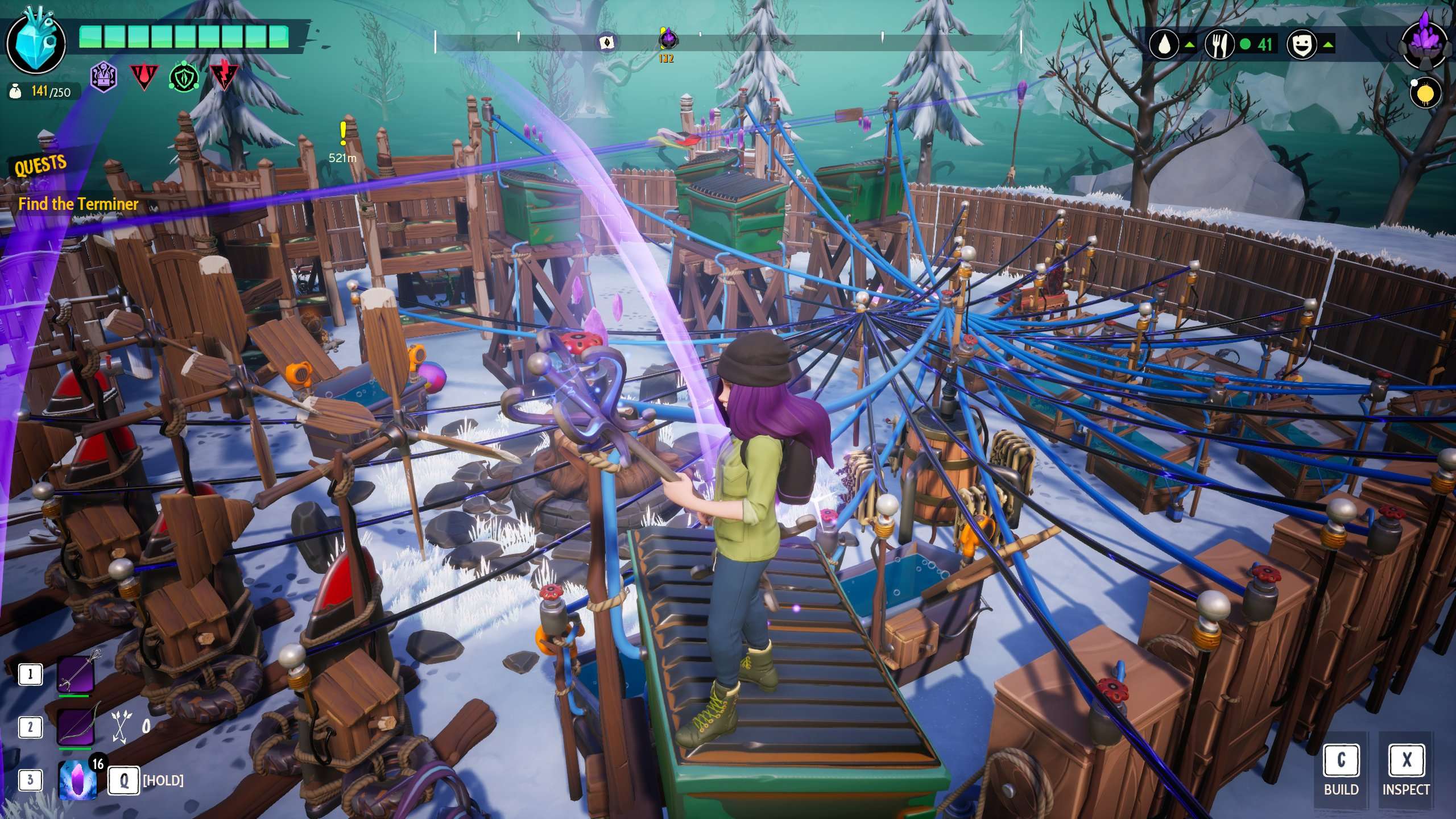
Which bring us on to the next big gameplay element of Drake Hollow, the reason to explore and clear each island from its aether infestation (black and red shrub thorns that need to be destroyed on the islands). The map is made up of small islands that are surrounded by a dangerous gas called aether that requires an item to travel through it. Once done, a waypoint can be put down and joined with another waypoint to enable the character to grind the purple rails to travel over the dangerous aether and travel faster to the furthest islands on the map. Waypoints are also used to join up broken delivery trucks that will transport their contents back to base on these waypoints. This is incredibly helpful for gaining stock of materials fast for the constructions that require a large amount to build, or to build supplies – health potions, waypoints, fire torches – to help with exploring.
I have already mentioned that the drakes are hidden across the map, but another key point is to find the materials to be able to build the items for the base. These are often found by smashing items in the environment. Food is also another element found around the map that can be returned to base to be put into the cauldron or added to a small vegetable patch to give the drakes some carrots or grapes to munch on (wait, does this make them cannibals?!). Weapons will sometimes drop as well, with this the main way of gaining new gear to fight with.
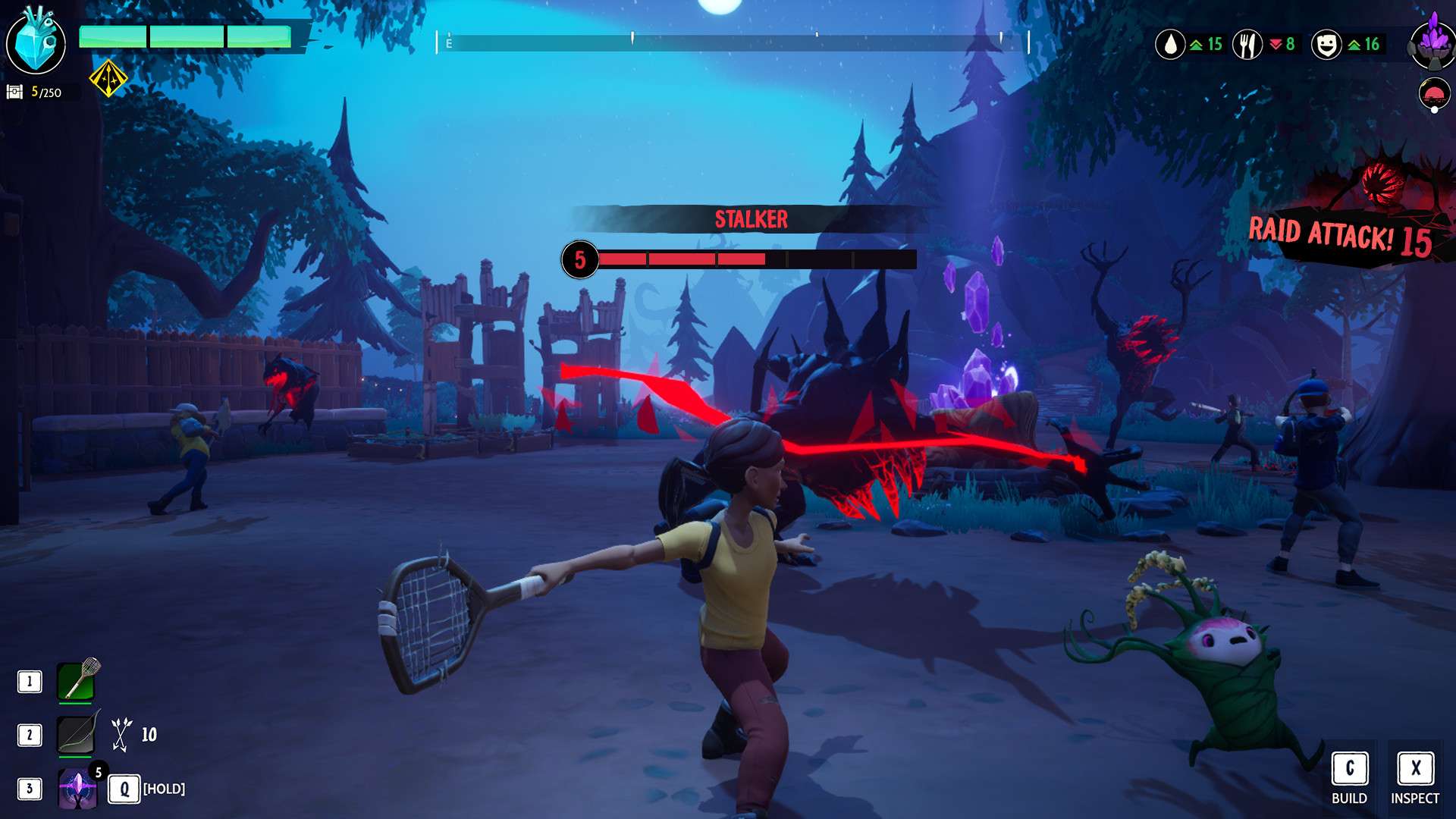
The main character can hold two weapon types, melee and range, with up to six held in each type at once. Weapons come in the typical action RPG colour scheme of grey, green, blue, purple and yellow to represent their rarity. In my time with the campaign, around 9 hours, I found baseball bats, 8 ball stick shifters, hatchets, pizza paddles, guitars, fishing rods, scythes, waffle irons and a few other household objects that make good for smashing ferals. On the range side there is less options, but still a fun selection, so expect to be using nail guns, bows, blunderbusses and a balloon launcher (think of this as a kid friendly grenade launcher).
Combat, sadly, is the weakest element of Drake Hollow, more so on the melee side compared to using range weapons. All range weapons behave differently – the balloon launcher has an arc to its travel, bow and arrow requires pulling and holding the string for more damage/distance and the blunderbuss has a nice spread shot. When it comes to the melee weapons, though, things are very similar and each of the weapons have the same three hit combo string and diving air attack slam. The only part that differentiates them is the speed of the combo string and range.
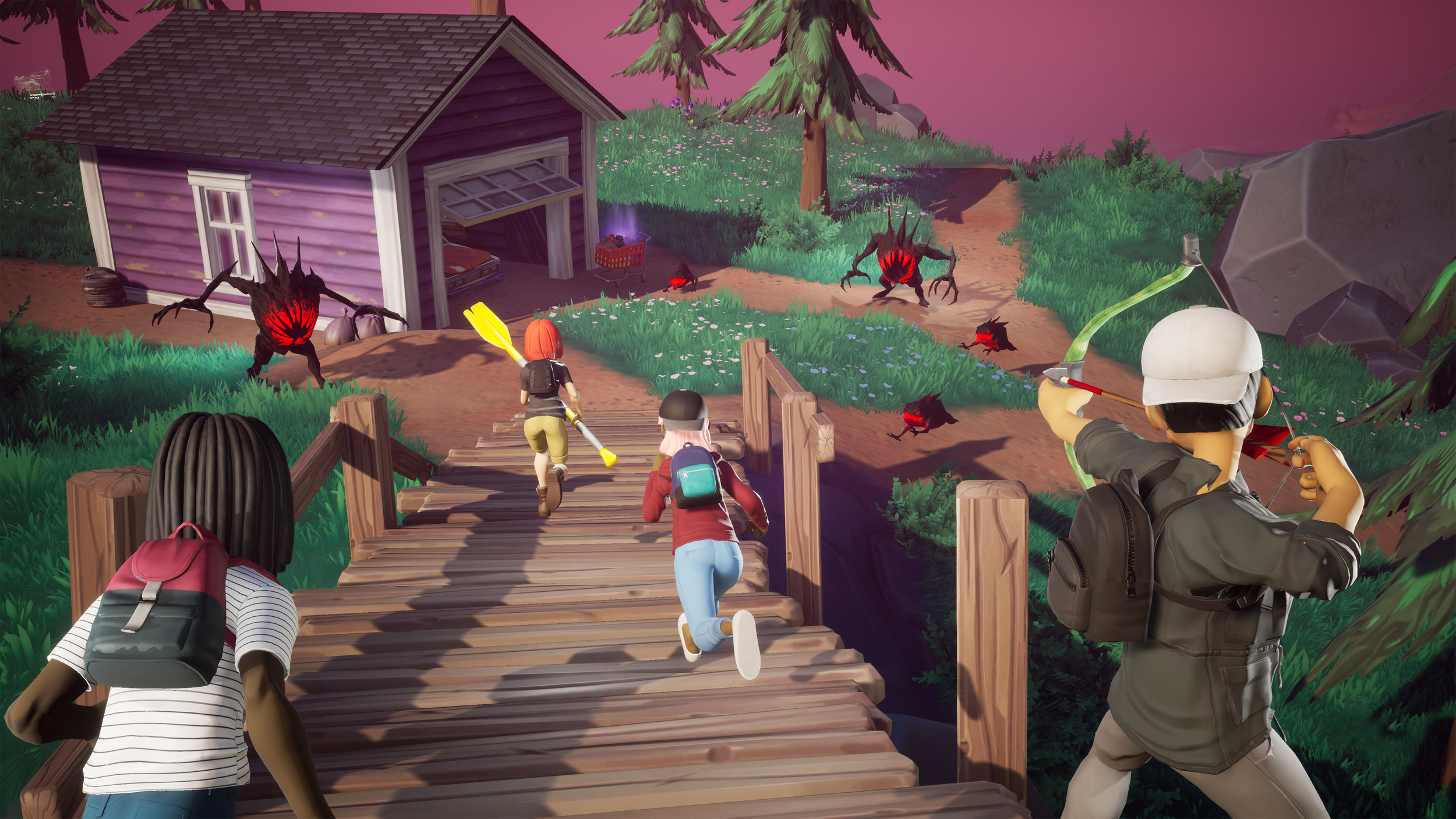
I am surprised that the combat is so one noted with its melee weapons, because the enemies are designed with different attack styles, but the design fails to make them impactful in combat, so it ends up being easy to run up to them and smack them a few times. There are small critters that like to attack in groups, so wide swings makes sense for those. The fast running dog like monsters that throw explosive mines on the ground require faster movement, and big armoured stalkers that take a lot of damage to kill require the use of blocking and dashing during their attack animation to hit them. There are a couple of others, but the enemy variety is thin pickings across the game’s campaign. Fighting with these monsters is not engaging enough, and once specific buffs are available, such as the life steal, fighting them requires no skill as enough health is given back on hit that one can hammer attack and not worry about blocking damage. It is a shame that the combat is so thinly developed, as the building element of Drake Hollow, the part where you get to grow the base into some crazy cable monstrosity as everything is powered by electric wire and water pumps, is rather satisfying when it all works.
Big praise goes to the game’s presentation. Drake Hollow is a beautiful looking game with a great use of that Unreal Engine cartoon aesthetics. Some people might see the relevance to Fortnite‘s art style, but it does much more with the style, with the environment looking lush and colourful, and of course, the drakes, the most adorable critters of 2020. It doesn’t take much to run Drake Hollow, so hardware from around six or so years ago will still be able to run this game, which is handy when it supports up to four players cooperative online. Be warned, the save file is only for the host, so each player will have to start their own game if they want to have a state saved on their account. This isn’t much of a problem if everyone plans to play together as achievements and stats are still unlocked no matter whose game is the host.

The final thing to talk about is the inclusion of Sandbox mode, a recent feature patched in during my review of the game. This inclusion is brilliant, because the campaign felt a bit on the tutorial side as it went through the game’s four seasons, introducing mechanics over the seasons before ending once the the last quest in winter was complete. This could probably be done on a second run in half the time, but for the first time it lasted around 8-9 hours to experience the four seasons – it felt like there was much more that could have been done to give this game more content. Sandbox fixes some of this with its unlimited season count and extending the base level from 12 to 25, with each level after 12 offering new cosmetics for the avatar, but fleshing out sandbox with more gear/buildings/enemies would have made it more impactful than offering random generated maps, but with the same content in them.
Drake Hollow can be bisected into its survival and combat gameplay elements. On one hand, survival and building aspect is very enjoyable – there is something rewarding about a base growing from nothing into a beautiful, drake living paradise, and seeing the drakes go about their business to entertain themselves. But the other side of its core gameplay, the combat, is painfully lacking, making combat quickly turn from exciting to repetitive, with nothing available to spice up the threat of the game’s feral enemies. It is a shame that Drake Hollow could not bring more in-depth combat, because everything else about the game is enjoyable, and as a bonus, it has a stellar visual design and cute plant people to warm up your heart. Once the campaign is experienced and a run of Sandbox is over, there is nothing to make players come back for more, so unless updates in the future extend the features of Drake Hollow, expect the life expectancy of this to be short compared to other survival games on the market.
